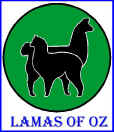
ALPACA FLEECE
| Understanding
Histograms (Fibre Test Results) AFD (Average Fibre Diameter): average thickness of each hair in microns (1 micron = 1/1000th of a
millimeter or approx. 1/25,000th of an inch) CV DEBUNKED: Don't be fooled by a higher CV. It can be higher because of a
very low AFD! An AFD of 20 microns is very fine! An SD of 5 microns is good,
which means the majority of fibres fall between 15 and 25 microns in diameter (5 microns
below the AFD and 5 microns above the AFD). I don't agree that fleeces can be
compared by CV's alone, in fact I would throw out the CV altogether! Comparing CV
(coefficient of variation) means that you are allowing a wider range of hair thicknesses
(higher SD = less even fleece) the higher the AFD is. A higher AFD means coarser
fibre (not good) and a higher SD means less even fleece (also not good). The lower
number the better for AFD, SD and %>30 microns. But a low CV (eg. 20) could just
mean the AFD is high! CV is a percentage: SD divided by AFD multiplied by 100.
There is no reason to allow a wider range (less even fleece) just because the AFD
is higher! A coarser fleece can still have good handle (soft feel) if it is an even
fleece (i.e. has a low SD). Comparing CV's is the same as saying, "This coarse,
uneven fleece is just as good as that fine, even fleece!" NOT TRUE! |